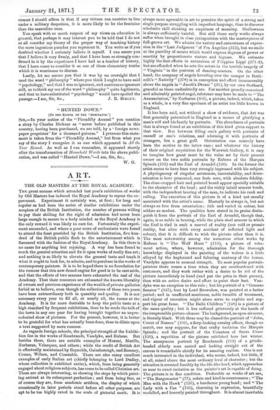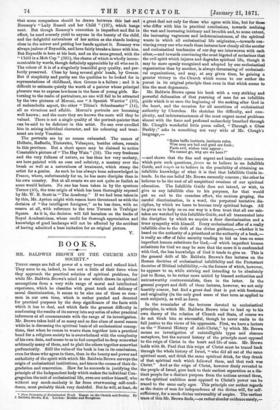A RT.
THE OLD MASTERS AT THE ROYAL ACADEMY. THE great success which attended last year's exhibition of works by Old Masters has induced the Royal Academy to repeat the ex- pernment. Experiment it certainly was, at first ; for long and regular as had been the series of similar exhibitions under the auspices of the British Institution, the number of persons willing to pay their shilling for the right of admission bad never been large enough to secure to a body minded as the Royal Academy is the only reward it was likely to care for. Fortunately the experi- ment succeeded, and where a poor score of enthusiasts were found to attend the feast provided by the British Institution, five hun- dred of the British public flock to the entertainment which is flavoured with the fashion of the Royal Academy. In this there is no cause for anything but rejoicing. A way has been found to reach the general attention and fix it upon works of really fine art ; and nothing is so likely to elevate the general taste and teach it what it ought to look for, to admire, and to purchase in the works of contemporary painters. It is to be hoped there is no foundation for the rumour that this new-found engine for good is to be cast aside, and that the efforts of two seasons have exhausted the zeal of the Academy. That their resources are exhausted the known liberality of owners and previous experience of the wealth of private galleries forbid us to believe, even though the collections of these two years have been extraordinary both in quantity and quality. It is not necessary every year to fill all, or nearly all, the rooms at the Academy. It is far more desirable to keep the public taste at a high standard by frequent exhibitions, than to be made the talk of the town in any one year for having brought together an unpre- cedented show of pictures. For the present, however, it is better to be grateful for what has actually been done, than to dilate upon a text suggested by mere rumour.
As regards foreign schools, the principal strength of the Exhibi- tion lies in the works of Rembrandt, Vandyke, and Rubens. But besides these, there are notable examples of Moroni, Murillo, Zurbaran, Velasquez, and others ; while the credit of British Art is effectually maintained by Reynolds, Gainsborougb, and Romney, Crome, Wilson, and Constable. There are also many excellent examples of early Italian art (chiefly belonging to Lord Dudley, whose collection is exhibited entire), which, from being generally engaged about religious subjects, has come to be called Christian art. These are always interesting, as showing the steps by which paint- ing arrived at its subsequent perfection ; and from being free, as of course they are, from academic artifices, the display of which occasionally in later periods stood before all other purposes, are apt to be too highly rated in the scale of pictorial merit. It is
always•more agreeable in art to perceive the spirit of a strong and single purpose struggling with imperfect language, than to discover scholastic skill cloaking an emptiness of meaning. Shallowness is always sufficiently hateful. But still these early works always suffer when brought in close juxtaposition with the masterpieces of full-grown art. We admire the variety and earnestness of expres- sion in the "Last Judgment " of Fra Angelico (313), but we smile at the puerility of means which would express degrees of power or sanctity by proportionate stature and bigness. We estimate highly the first efforts in naturalism of Filippino Lippi (271-2), but are offended when he sets the actors in the terrible tragedy of " Virginia" in the postures of dancing-masters. On the other hand, the company of angels hovering over the manger in Botti- celli's " Nativity " (278) is in conception and effect immeasurably above the angels in "Jacob's Dream" (31), by our own Stothard, graceful as these undoubtedly are. For another grandly-conceived and admirably painted angel, reference may here be made to " The Annunciation," by Zurbaran (405), a picture, indeed, which, taken as a whole, is a very fine specimen of an artist too little known in England.
It has been said, not without a show of evidence, that Art was first generally patronized in England as a means of glorifying a man's self and his family by portraits. The abundance of portraits that is always found at an exhibition of this kind gives support to that view. But between filling one's gallery with portraits of oneself or one's relations, and adorning it with portraits of strangers, lies a great gulf. Ostentation can scarcely have been the motive in the latter case ; and whatever the history of their original acquisition for the Warwick Gallery, it is easy to imagine how great must be the value set by their present owner on the two noble portraits by Rubens of the Marquis Spinola (103) and the Earl of Arundel (158). In the former the artist seems to have been very strongly impressed with his subject. A physiognomy of singular astuteness, inscrutability, and deter- mination is here presented, one feels sure, with absolute fidelity. The close-cropped hair and pointed beard appear specially suitable to the character of the head ; and the richly inlaid armour tends, with the independent bearing of the man, to indicate his rank and calling. The execution of this picture is of a kind not usually associated with the artist's name. Masterly he always is, but not always so free from ostentation ; rich and varied in colour, but seldom so modest. The qualities here stated in its praise distin- guish it from the portrait of the Earl of Arundel, though that, again, is so noble in bearing, while the plain steel armour in which the Earl is clad is such a marvel of reality (not cold or prosaic reality, but alive with every accident of reflected light and colour), that it is difficult to wish the picture other than it is. The most noteworthy among the numerous other works by Rubens is " The Wolf Hunt " (110), a picture of vehe- ment action, where, however, admiration for the thorough knowledge displayed in the painting of the wolves is a little alloyed by the haphazard and faltering anatomy of the horses. Vandyke appears in unusual strength. To most popular portrait- painters there comes a time when they are overburdened with customers, and they work rather with a desire to be rid of the picture immediately in band (and put the price in their purses), than with an active desire and effort to paint their best. Van- dyke was no exception to this rule ; but his portrait of a "Genoese Senator " (147), lent by Lord Brownlow, was painted at a better period ; and in unaffected manliness, noble breadth of treatment, and vigour of execution might alone serve to explain and sup- port his great fame. "The Balbi Children" (148) is a picture of the same quality ; but it has suffered grievously at the hands of the irrepressible picture-cleaner. The background, an open-air scene, is literally black. With these may be classed the portrait of "John, Count of Nassau" (106), a fiery-looking cavalry officer, though no match, one may suppose, for that crafty tactician the Marquis Spinola ; and the portrait of the Countess of Santa Croce (150), a repetition of the picture exhibited here last winter. The anonymous portrait by Rembrandt (114) of a grizzle- headed elderly man seated and looking straight out of the canvas is remarkable chiefly for its amazing realism. One is not much interested in the individual, who seems, indeed, but little, if at all, raised above the most ordinary level of character ; but the attention is arrested forcibly by the life-like head, which approaches as near to exact imitation as the painter's art is capable of doing. The picture is in fine condition. Preferable as works of art are, " The Burgomaster " (77), sedate and kind in countenance ; " The Man with the Hawk " (126), a handsome young head ; and " The Lady with a Fan " (136), charming in expression, beautifully modelled, and honestly painted throughout. It is almost inevitable that some comparison should be drawn between this last and Romney's "Lady Russell and her Child " (137), which hangs next. But though Romney's execution is imperfect and fiat in effect, he need scarcely yield to anyone in the beauty of the child, and the delightful naturalness of her action as she stands looking close in the mirror and patting her hands against it. Romney was always jealous of Reynolds, and here fairly breaks a lance with him. But Reynolds is here at his best, and on the same ground, with the " Child in a Mob Cap " (385), the charm of which is wholly incom- municable by words, though definitely appreciable by all who see it. The colour of it is of a singularly beautiful grey quality, and per- fectly preserved. Close by hang several girls' heads, by Greuze. But if simplicity and purity are the qualities to be looked for in representations of childhood, then Greuze is a failure ; and it is difficult to estimate quietly the worth of a painter whose principal pleasure was to express lewdness in the faces of young girls. Re- turning to the realm of portraiture, no one will fail to be attracted by the two pictures of Moroni, one " A Spanish Warrior" (10), of melancholic aspect, the other " Titian's Schoolmaster " (14), all as vivacious and affable. Moroni's portraits are becoming well known ; and the more they are known the more will they be valued. There is not a single quality of the portrait-painter that can be said to be deficient in this artist. No one ever excelled him in seizing individual character, and his colouring and treat- ment are truly "Venetian.
The portraits are by no means exhausted. The names of Holbein, Raffaelle, Tintoretto, Velasquez, besides others, remain in this province. But a short space may be claimed to notice Constable's picture of " The Hay Wain " (16). The very freshness and the very fullness of nature, no less than her very modesty, are here painted with an ease and sobriety, a mastery over the brush as well as a naturalness of treatment, which stamp the artist for a genius. As such he has always been acknowledged in France, where, unfortunately for us, he has more disciples than in his own country. But at all events we are not quite so foolish as some would believe. No one has been taken in by the spurious Turner (40), the true origin of which has been thoroughly exposed by Mr. W. B. Scott in " The Academy." If we had been taken in by this, Mr. Ayrton might with reason have threatened us with the derision of " the intelligent foreigner," as he has done, with no reason at all, with reference to the true Turners in Trafalgar Square. As it is, the decision will fall harmless on the backs of Royal Academicians, whose credit for thorough appreciation and knowledge of good landscape will not be affected by the accident of having admitted a base imitation for an original picture.
V.































 Previous page
Previous page